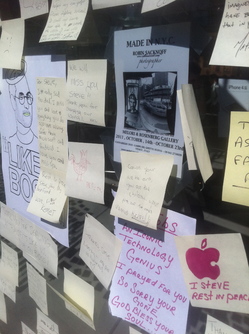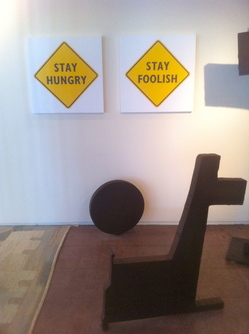Last week’s surreal series of events began, for me, with my face on CNN—or more accurately, on an iPhone talking about the iPhone on CNN. Very meta.
You might’ve heard that Apple announced a new phone last week, and as per usual, the media mobilized for the unveiling. CNN reporter George Howell invited me to pitch in for his piece about how smartphones have changed the texture of our lives. This hootenanny came off well enough, I think, and I managed to maintain my dignity, probably the best one can hope for in a television appearance. Here’s the piece:
My money quote from the story happens to be both heartfelt and true:
This is in many ways the first time in my adult life with this device that my childhood vision of the future has come to life.
The idea of a device like the iPhone first captured the imagination of a six-year-old Josh in 1977. In the 30 years while I waited for its arrival, I contented myself to learn technology through Apple products. In the summer of 1980, my pal John Quaintance and I invested hours—weeks!—in front of his Apple ][ inputing page after page of hex bytes from print magazines, all to play the video games that lurked within that code. I learned BASIC on that Apple. My first summer job, in 1983, was devoted to earning enough to buy myself an Apple ][e, this despite a well-meaning friend who suggested that I instead spend the cash on better clothes—a completely sensible suggestion given my wardrobe of the era. Two years later, my summer wages went to the so-called Fat Mac, the second-generation Macintosh, sporting a remarkable 512K of RAM.
Apple sparked not only my interest in technology, but my passion for it, too. That’s always been Apple’s magic under Steve Jobs: to warm hardware and software with a sense of wonder and possibility, elevating technology beyond tool to genuine experience. There’s plenty of invention outside of Apple, sure, but it’s inarguable that the iPhone kicked off the current era of smartphone innovation—not by inventing the form but by refining and humanizing it.
So I was happy to say as much in my first national news appearance. I thought I was marking the next generation of a device, but it was instead an unwitting tribute to a man.
A phone call
Hours after this thing aired, I was having dinner with an old friend and found a voicemail waiting for me afterward. A friend had called to share news I hadn’t yet heard:
Steve Jobs is dead, and I thought I should call to tell you in case you didn’t know. I mean… Steve Jobs is dead. I hope you’re okay.
“I hope you’re okay,” is a strange thing to say about the death of an aloof billionaire CEO, right? But it’s true: I wasn’t okay. The voicemail left me stricken. I was driving, and I had to pull over. Gather myself. I was surprised how affected I was by this news. I wasn’t alone, as the flood of articles, tweets, blog posts, and general rending of garments demonstrated over the next few days.
Everything I’ve learned about Steve Jobs suggests that he was a bully. He intimidated. He was blunt and unkind. He was arrogant. He told people their ideas were “dumb” if he didn’t agree. His mind and imagination operated at a different level, and one has the impression that he looked down on the rest of us as half-brained monkeys wallowing in our own poo.
Geniuses often have surly reputations. It must be frustrating to be surrounded by people who slow you down, who can’t understand your vision, who grasp only the bare surface of the ideas you try to communicate. Perfectionism is rarely pretty.
And yet I loved this guy. What a beautiful S.O.B.
For all of his disdain and impatience, the wonder of Steve Jobs is that he seemed genuinely motivated by the idea of making life better for the rest of us half-brained monkeys. He talked in terms of culture and art and liberal arts, notions that are not typically associated with circuit boards. His Willy Wonka laboratories of gizmos and movies churned out consumer products intended both to delight and elevate.
PostIt notes, shrines, and Tufte

Yesterday I was back in New York, and I happened by the Apple Store on 14th Street. The windows are festooned with PostIt notes with personal messages to Steve. There are some drawings, too, and several little shrines made of flowers, some of apples. A little throng of people were gathered on the sidewalk, apparently taking a moment to remember the man, to take in how much he meant to others, too.
Again, I was surprise how affected I was, not only by my own emotion about Steve’s passing, but by the fact that this aloof industrialist had somehow touched so many others, too.
I wandered over to the nearby galleries in Chelsea and wandered into Edward Tufte’s ET Modern gallery where I was surprised to find the man himself. Tufte was charming and eager to talk about his art. The gallery is full of his enormous installation sculpture, as well as his collection of highway-style warning signs, which by chance included a pair of phrases now strongly associated with Steve Jobs: “stay hungry” and “stay foolish.”

“You probably know that line ‘stay hungry, stay foolish’ from Steve Jobs’ commencement address,” Tufte said to me. “But it’s actually from the Whole Earth Catalog.” Indeed, it was the farewell text of the back cover of the counter-culture magazine’s last issue. Jobs’ commencement address was in part a meditation on death, a farewell text in itself and an appropriate sign-off for a counter-cultural hero who somehow moved himself to the center of culture.[1]
Jobs was an innovator in culture perhaps even more than business or technology. On Friday, two days after Steve’s death, my friend Karen McGrane gave a lively talk about the history of technology and interaction design. Much of this history includes tales of very smart people whom most folks have never heard of—and likely never will.[2] These were the inventors, the people who figured out how to make technology do new things. But their creations—the ENIAC or NLS computers, for example—lacked humanity, their complexity buried under impenatrable complication. Steve Jobs’ contribution—why his name will be remembered while those of crucial inventors won’t—was to take existing technology and humanize it. “That’s what Steve Jobs engineered,” Karen said: “The triumph of design over invention.”
In today’s New York Times, Ross Douthat got at a similar idea:
There would have been some sort of desktop computer without the Macintosh, some sort of popular smartphone without the iPhone, some kind of big-screen computer animation without Pixar. But there was no guarantee that any of these technological wonders would be so exquisite, or that the age of information would also be an age of artistry.…If [tomorrow’s innovators] learn anything from Jobs, it should be that their vocation isn’t just about uniting commerce and technology. It’s about making the modern world more beautiful as well.
Steve, you were the one who figured out how to put the ghost in the machine. Thank you, you beautiful S.O.B.
1. "But what a terrible thing to say to a bunch of 20-year olds," Tufte joked. "I've done some of these commencement addresses myself, and I know what I'm talking about here. 'Stay hungry, stay foolish' is the last thing you should say to a bunch of young people who all want to be investment bankers." Back
2. Karen talked about pioneers Pres Eckert and John Mauchly, who despite being inventors of THE FIRST COMPUTER are hardly household names. Ditto for Vannevar Bush and his Whirlwind project at MIT or Ivan Sutherland and his Sketchpad interface, the ancestor of the modern graphic user interface. Back





